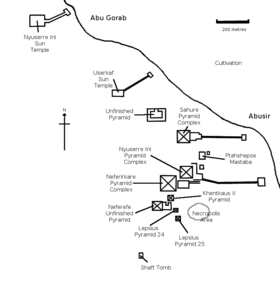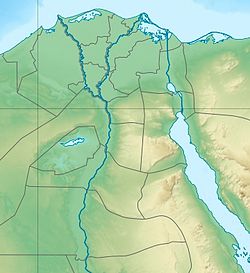Abusir
 | |
| Location | Egypt |
|---|---|
| Region | Giza Governorate |
| Coordinates | 29°54′N31°12′E/ 29.9°N 31.2°E |
| Criteria | Cultural: (i)(iii)(vi) |
| Designated | 1979(3rdsession) |
| Part of | Memphis and its Necropolis – the Pyramid Fields from Giza to Dahshur |
| Reference no. | 86-002 |
| Busiri inhieroglyphs | |||||
|---|---|---|---|---|---|
Abusir(Arabic:ابو صيرEgyptian Arabic pronunciation:[æbuˈsˤiːɾ];Egyptianpr wsjr;Coptic:ⲃⲟⲩⲥⲓⲣⲓbusiri,"the resting place ofOsiris";Ancient Greek:Βούσιρις) is the name given to anancient Egyptianarchaeologicalpyramid complexcomprising the ruins of 4 kings' pyramids dating to theOld Kingdomperiod, and is part of thePyramid Fieldsof theMemphis and its NecropolisUNESCOWorld Heritage Site.[1]
The pyramid complex is named after the neighbouring village of Abusir, in the markaz (county) ofBadrashin,Giza.[2]The Abusir pyramid complex is located on theWestern Desertplateau at the edge of the cultivated plain, with theGiza Pyramidsto its north, andSaqqarato its south, and served as one of the main elite cemeteries for the ancient Egyptian capital city ofMemphis.Several other villages in northern and southern Egypt are named Abusir or Busiri.
The locality of Abusir took its turn as the focus of the prestigious western burial rites operating out of the then-capital of Memphis during theOld Kingdom5th Dynasty.As an elite cemetery, neighbouringGizahad by then "filled up" with the massivepyramidsand other monuments of the4th Dynasty,leading the5th Dynastypharaohsto seek sites elsewhere for their own funerary monuments.
Abusir was the origin of the largest find ofOld Kingdompapyrito date — theAbusir Papyri.In the late nineteenth century, a number of Western museums acquired collections of fragmentary papyri from the administrative (temple) records of one Abusir funerary cult, that of kingNeferirkare Kakai.This discovery was supplemented in the late twentieth century when excavations by aCzechexpedition to the site revealed papyri from two other cult complexes, that of the pharaohNeferefre(also read Raneferef) and for the king's motherKhentkaus II.
The Czech Institute of Egyptology of theFaculty of Arts, Charles University in Praguehas been conducting excavations at Abusir since 1960, beginning with the mastaba ofPtahshepses,directed byZbyněk Žába.The concession was extended since 1976 with the southern part of the royal necropolis, directed byMiroslav Verner.Since 1991, the institute excavates also at the site of Abusir South. The excavations are presently directed by Miroslav Bárta.
There are considerablecatacombsnear the ancient town of Busiris, as stated in (Plinyxxxvi. 12. s. 16). To the south of Busiris one great cemetery appears to have stretched over the plain. TheHeptanomiteBusiris was in fact a hamlet standing at one extremity of the necropolis of Memphis.
Necropolis
[edit]

Earliest tombs on the site are from the Early Dynastic Period, First Dynasty. Tombs, including stairway tombs, were uncovered north of pyramid field.[3]
There are a total of 4 kings' pyramids at this site, which served as the main royal necropolis during the Fifth Dynasty. The quality of construction of the Abusir pyramids is inferior to those of the Fourth Dynasty; perhaps signalling a decrease in royal power or a less vibrant economy. They are smaller than their predecessors, and are built of low quality local stone. All of the major pyramids at Abusir were built asstep pyramids,although the largest of them—the Pyramid of Neferirkare—is believed to have originally been built as a step pyramid some seventy metres in height and then later transformed into a "true" pyramid by having its steps filled in with loose masonry.
Complete list of excavated structures until the year 2019 is available in this article.[4]The map is also published online as a searchable application.[5]
Major pyramids
[edit]The three major royal pyramids are
- the earliest,Pyramid of Sahure,known for its finely carved reliefs
- thePyramid of Neferirkare Kakai,the tallest pyramid at the site
- thePyramid of Niuserre,the most intact pyramid at the site
The two unfinished royal pyramids are
- the incompletePyramid of Neferefre[6]
- theunfinished pyramid of Shepseskare?[7]
Smaller pyramids
[edit]- the pyramid of QueenKhentkaus II,wife of Neferirkare and mother of Neferefre and Niuserre[8]
- Lepsius Pyramidno. 24 — The pyramid belonged to a woman, likely a queen. The name of the vizier Ptahshepses appears among builders' marks, which dates the pyramid to the time of Pharaoh Nyuserre[7]
- Lepsius Pyramidno. 25 — Likely the pyramid of a queen from the Fifth Dynasty[7]
Mastabas of courtiers
[edit]The tombs of several high officials and family members are located in the direct vicinity of their king's pyramid:
- themastaba of Ptahshepses(vizier under Nyuserre)[9]
Four mastabas south-east of the pyramid complex ofRaneferefcreate a so-called "Nakthsare" cemetery, presumably tombs of the persons related to KingRaneferef:
- the mastaba of Prince Nakhtsare (son of Raneferef or Nyuserre)
- the mastaba of "count" Kakaibaef
- the mastaba of QueenKhentkaus III,likely a spouse ofRaneferef
- the mastaba of anonymous owner AS 31
Abusir South
[edit]Directly north of Saqqara is a cemetery of lower-ranking officials of the Early Dynastic Period and Old Kingdom. The earliest First Dynasty tombs are on the so-called "Bonnet cemetery" named afterHans Bonnet,who published the site.[10]It was excavated in 1910 byGeorg Steindorffand Uvo Hölscher. Recently, copper artefacts in the collection of Leipzig University, from the site, were studied. One vessel, ÄMUL 2162, was made of a peculiar material, arsenical copper with nickel, which could be imported to Egypt.[11]
The Old Kingdom cemetery at Abusir South includes the following tombs:
- the tomb of Ity (early Fourth Dynasty)[12]
- the tomb ofHetepi(priest, beginning of Third Dynasty)[13]
- the tomb of Nyankhseshat (property custodian of the king, early Fourth Dynasty), with a stela of a Fifth-Dynasty official Sekhemka and his presumed spouse Henutsen[14]
- the tomb of Kaaper (architect and priest, early Fifth Dynasty)[12]
- the tomb of Rahotep (priest, end of Fifth Dynasty)
- the tomb of Fetekti (priest, end of Fifth Dynasty)
- the tomb ofQarand his sons (vizier, early Sixth Dynasty, sons from late Sixth Dynasty, reign ofPepi II Neferkare)[15]
- the rock cut tomb of New KingdomNakhtmin (charioteer)[16]
Saite-Persian cemetery
[edit]On a small hill directly south of the pyramid of Neferefre is a cemetery of tombs from the Saite period:
- the tomb ofUdjahorresnet[17]
- the tomb ofIufaa[18]
- the tomb ofMenekhibneko[19]
- the tomb ofPadihor
- tomb R3
A temple
[edit]Also found at Abusir were substantial remains of a Ramesside temple, perhaps built byRamses II.The temple lies about 500 meters south east of the pyramids, close to the cultivation in the desert. The main building of the temple was built of limestone. There were three cellars, a small hall with four columns and a courtyard (with mudbrick walls) with ten limestone columns. The limestone building was placed within a larger complex made of mud bricks with a pylon and magazines.[20]The temple seems to have been dedicated to the solar cult, in particular the gods Ra, Amun, and Nekhbet. Fragments of polychrome reliefs and numerous examples of the titles of Ramesses II have been recovered.[21]The temple was built above the mud brick tombs of Third and Fifth Dynasty.[22]
Site looting during 2011 protests
[edit]Abusir, Saqqara and Dahshur suffered damage by looters during the2011 Egyptian protests.Part of thefalse doorfrom the tomb of the priest Rahotep was stolen, and store rooms were broken into.[23][24]The looted structures are mapped out e.g. in this article.[25]
Climate
[edit]Köppen-Geiger climate classification systemclassifies its climate ashot desert(BWh),[26]as the rest ofEgypt.
| Climate data for Abusir | |||||||||||||
|---|---|---|---|---|---|---|---|---|---|---|---|---|---|
| Month | Jan | Feb | Mar | Apr | May | Jun | Jul | Aug | Sep | Oct | Nov | Dec | Year |
| Mean daily maximum °C (°F) | 19.6 (67.3) |
21.2 (70.2) |
24.5 (76.1) |
29 (84) |
32.9 (91.2) |
35.3 (95.5) |
35.5 (95.9) |
35.2 (95.4) |
32.9 (91.2) |
30.7 (87.3) |
25.9 (78.6) |
21.4 (70.5) |
28.7 (83.6) |
| Daily mean °C (°F) | 13.5 (56.3) |
14.5 (58.1) |
17.5 (63.5) |
21.1 (70.0) |
24.8 (76.6) |
27.5 (81.5) |
28.4 (83.1) |
28.3 (82.9) |
26.2 (79.2) |
24.1 (75.4) |
19.8 (67.6) |
15.4 (59.7) |
21.8 (71.2) |
| Mean daily minimum °C (°F) | 7.4 (45.3) |
7.9 (46.2) |
10.6 (51.1) |
13.3 (55.9) |
16.8 (62.2) |
19.8 (67.6) |
21.3 (70.3) |
21.4 (70.5) |
19.5 (67.1) |
17.5 (63.5) |
13.7 (56.7) |
9.4 (48.9) |
14.9 (58.8) |
| Averageprecipitationmm (inches) | 4 (0.2) |
3 (0.1) |
2 (0.1) |
1 (0.0) |
0 (0) |
0 (0) |
0 (0) |
0 (0) |
0 (0) |
0 (0) |
2 (0.1) |
4 (0.2) |
16 (0.7) |
| Source:Climate-Data.org,altitude: 18m[26] | |||||||||||||
See also
[edit]- Memphite Necropolis
- List of ancient Egyptian towns and cities
- List of ancient Egyptian sites,including sites of temples
- Double Pyramid
- List of megalithic sites
References
[edit]- ^"Memphis and its Necropolis – the Pyramid Fields from Giza to Dahshur".UNESCO World Heritage Centre.United Nations Educational, Scientific, and Cultural Organization.Retrieved7 September2021.
- ^"Markaz al-Badrashin Map".giza.gov.eg.Retrieved2023-01-22.
- ^Radwan, Ali (1991). "Ein Treppengrab der 1. Dynastie aus Abusir".Mitteilungen des Deutschen Archäologischen Instituts, Abteilung Kairo.47:305–308.
- ^Bárta, Miroslav; Brůna, Vladimír; Bareš, Ladislav; Krejčí, Jaromír; Dulíková, Veronika; Odler, Martin; Vymazalová, Hana (2020)."Map of archaeological features in Abusir"(PDF).Prague Egyptological Studies.25:7–34.
- ^Brůna, Vladimír (2019)."Map of the archaeological objects in Abusir".Retrieved1 May2023.
- ^Verner, Miroslav (2006).The pyramid complex of Raneferef.Abusir. Prague: Czech Institute of egyptology, Faculty of arts, Charles university in Prague Academia, publishing house of the academy of sciences of the Czech Republic.ISBN978-80-200-1357-6.
- ^abcVerner, Miroslav. The Pyramids: The Mystery, Culture, and Science of Egypt's Great Monuments. Grove Press. 2001 (1997).ISBN0-8021-3935-3
- ^Verner, Miroslav; Posener-Kriéger, Paule; Jánosi, Peter, eds. (1995).The Pyramid complex of Khentkaus.Abusir. Praha: Univ. Carolina Pragensis Acad.ISBN978-80-7066-909-9.
- ^Krejčí, Jaromír (2009).The architecture of the mastaba of Ptahshepses.Abusir. Praha: Czech Institute of Egyptology.ISBN978-80-200-1728-4.
- ^Bonnet, Hans (1928).Ein frühgeschichtliches Gräberfeld bei Abusir(in German) (1 ed.). Leipzig: Hinrichs’sche Buchhandlung.
- ^Kmošek, Jiří; Odler, Martin; Fikrle, Marek; Kochergina, Yulia V. (2018)."Invisible connections. Early Dynastic and Old Kingdom Egyptian metalwork in the Egyptian Museum of Leipzig University".Journal of Archaeological Science.96:191–207.doi:10.1016/j.jas.2018.04.004– via Elsevier Science Direct.
- ^abBárta, Miroslav (2001).The cemeteries at Abusir South I(1 ed.). Praha: Czech Institut of Egyptology.ISBN978-80-86277-18-9.
- ^Abusir XIX: Tomb of Hetepi (AS 20), Tombs AS 33-35 and AS 50-53.Excavations of the Czech institute of egyptology. Prague: Charles University, Faculty of arts. 2010.ISBN978-80-7308-325-0.
- ^Odler, Martin; Peterková Hlouchová, Marie; Dulíková, Veronika (2021)."A unique piece of Old Kingdom art: the Funerary Stela of Sekhemka and Henutsen from Abusir South".Ägypten und Levante(in German).31:403–424.doi:10.1553/AEundL31s403.ISSN1015-5104.
- ^Bárta, Miroslav (2009).Abusir South 2: tomb complex of the vizier Qar, his sons Qar Junior and Senedjemib, and Iykai.Prague: Czech Institute of Egyptology Dryada.ISBN978-80-87025-21-5.
- ^Daoud, Khaled Abdalla; Farag, Sabry; Eyre, Christopher J. (2016). "Nakht-Min: Ramesses II's charioteer and envoy".Egyptian Archaeology.48:9–13.
- ^Bareš, Ladislav; Smoláriková, Květa, eds. (1999).The shaft tomb of Udjahorresnet at Abusir(1. vyd ed.). Praha: Universitas Carolina Pragensis, The Karolinum Press.ISBN978-80-7184-822-6.
- ^Bareš, Ladislav; Smoláriková, Květa (2008).The shaft tomb of Iufaa.Abusir. Prague: Czech Institute of Egyptology, Faculty of Arts, Charles University in Prague.ISBN978-80-7308-238-3.
- ^Bareš, Ladislav; Smoláriková, Květa (2011).Abusir XXV: the shaft tomb of Menekhibnekau.Excavations of the Czech Institute of Egyptology (1 ed.). Prague: Czech Institute of Egyptology, Faculty of Arts, Charles University in Prague.ISBN978-80-7308-380-9.
- ^M. Bárta, L. Varadzin, J. Janák, J. Mynářová, V. Brůna:The temple of Ramesses II in Abusir,inEgyptian Archaeology,Spring 2018, 52, 10-14
- ^"Abusir Necropolis | Ancient Egypt Online".Retrieved2022-07-25.
- ^Odler, Martin; Peterková Hlouchová, Marie; Arias Kytnarová, Katarína; Havelková, Petra (2018)."New Egyptian tomb type found at Abusir South? Report on the excavations of mud brick complex AS 103"(PDF).Prague Egyptological Studies.21:27–34.
- ^"Egyptological Looting Database 2011".
- ^"iDNES.cz".
- ^Odler, Martin; Dulíková, Veronika; Juřičková, Lucie (2013)."Molluscs from the Stone and Mud-brick Tombs in Abusir (Egypt) and the Provenance of so-called" Nile-mud ""(PDF).Interdisciplinaria Archaeologica - Natural Sciences in Archaeology.IV(1): 9–22.doi:10.24916/iansa.2013.1.1.
- ^ab"Climate: Abu Sir - Climate graph, Temperature graph, Climate table".Climate-Data.org.Retrieved28 October2013.
External links
[edit]- Czech Institute of Egyptology: Abúsír, the site
- Interactive map of the archaeological structures in Abusir
- Prague Egyptological Studies,online open access journal with the latest research from Abusir site
- Egyptian monuments: Abusir Necropolis
- Waseda University Expedition to Abusir SouthArchived2018-10-01 at theWayback Machine

